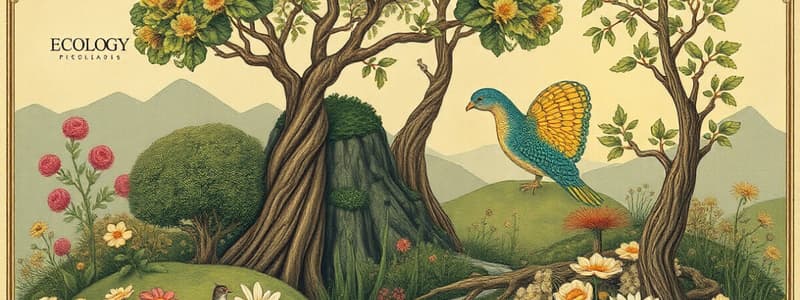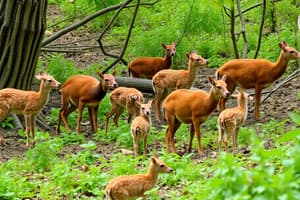Podcast
Questions and Answers
What is the scientific study of interactions among organisms and their environment called?
What is the scientific study of interactions among organisms and their environment called?
- Biology
- Zoology
- Botany
- Ecology (correct)
Which level of ecological organization includes all other levels?
Which level of ecological organization includes all other levels?
- Biosphere (correct)
- Population
- Ecosystem
- Community
What are the two main components that make up an ecosystem?
What are the two main components that make up an ecosystem?
- Plants and animals
- Living and non-living
- Organic and inorganic
- Biotic and abiotic (correct)
What is the primary source of energy for most ecosystems?
What is the primary source of energy for most ecosystems?
In an ecosystem, what happens to energy as it moves from one organism to another?
In an ecosystem, what happens to energy as it moves from one organism to another?
What is the term for the process where materials are continuously circulated between biotic and abiotic components in an ecosystem?
What is the term for the process where materials are continuously circulated between biotic and abiotic components in an ecosystem?
Which of the following is an example of an abiotic factor that affects organisms in an ecosystem?
Which of the following is an example of an abiotic factor that affects organisms in an ecosystem?
What is the term for the role a species plays within its community, including its habitat, food, and interactions?
What is the term for the role a species plays within its community, including its habitat, food, and interactions?
What term describes a relationship where one species benefits and the other is harmed?
What term describes a relationship where one species benefits and the other is harmed?
What is the process of change in the species structure of an ecological community over time called?
What is the process of change in the species structure of an ecological community over time called?
Flashcards
What is an ecosystem?
What is an ecosystem?
A functional unit of ecology with biotic and abiotic components interacting dynamically.
What is ecology?
What is ecology?
The scientific study of interactions among organisms and their environment.
What is a population?
What is a population?
Organisms of the same species living in the same habitat at the same time.
What is a community?
What is a community?
Signup and view all the flashcards
What is the biosphere?
What is the biosphere?
Signup and view all the flashcards
Energy vs. Material Flow
Energy vs. Material Flow
Signup and view all the flashcards
What is biomass?
What is biomass?
Signup and view all the flashcards
What is a climax community?
What is a climax community?
Signup and view all the flashcards
What is commensalism?
What is commensalism?
Signup and view all the flashcards
What is mutualism?
What is mutualism?
Signup and view all the flashcards
Study Notes
- The study of interactions between organisms and their environment is ecology.
- Ecology is studied at different levels of organizations: species, population, community, ecosystem, biome, and biosphere.
Levels of organization in ecology
- A species consists of organisms that can interbreed to produce fertile offspring.
- At the species level, ecologists study adaptations to the environment.
- A population comprises organisms of the same species living in the same habitat at the same time.
- At the population level, ecologists study environmental factors affecting population size.
- A community includes all populations of different species in the same habitat at the same time.
- At the community level, ecologists study interactions among populations.
- An ecosystem is a unit consisting of a community of organisms and the physical environment.
- Energy flow and material cycling are studied at the ecosystem level.
- A biome comprises a group of ecosystems with similar climate and communities.
- At the biome level, ecologists study how global climate changes affect biomes.
- The biosphere is the highest level of organization and includes all parts of Earth that support life.
- At the biosphere level, the ecological impact of human activities is studied.
Ecosystems
- The ecosystem is the basic functional unit of ecology, composed of biotic (living) and abiotic (non-living) components.
- Biotic components are the community of organisms; abiotic components are the physical environment (soil, water, climate).
- Ecosystems can be small (pond) or large (ocean), but all are self-sustaining, stable, and dynamic.
Organism Interactions
- Organisms in an ecosystem interact by feeding on each other or competing for resources.
Environment
- Organisms interact with their environment, adapting to abiotic factors while also affecting the environment.
Energy Flow
- Energy flows from one organism to another as chemical energy in food as organisms feed on each other.
- Energy cannot be recycled, and eventually leaves the ecosystem as heat.
- Constant energy input is essential to sustain life and maintain ecosystem stability.
- Sunlight is the primary source of energy for most ecosystems, converted into chemical energy by plants through photosynthesis.
Material Cycling
- Unlike energy, materials are cycled between the biotic and abiotic components of an ecosystem.
- The elements that make up today’s organisms have existed since Earth’s formation and are returned to the environment when the organism dies, then reused.
Hong Kong Ecosystems
- Hong Kong possesses diverse ecosystems within its small area.
- Each ecosystem type is defined by its specific environment and the organisms that inhabit it.
- Rocky shores are marine ecosystems with rocks and organisms adapted to withstand strong waves, and resist desiccation.
- Mangroves are intertidal wetland ecosystems in estuaries where freshwater meets the sea; soil is waterlogged with high salt content.
- Freshwater streams have flowing water from upstream to downstream.
- The speed of water flow is a major factor influencing the distribution and abundance of organisms.
- Woodlands in Hong Kong are dominated by broad-leaved trees and support a variety of animals.
- Grasslands are dominated by grasses and herbs. Frequent grazing or fire prevents tree growth.
Aquaponics
- Aquaponics combines aquaculture (raising fish) and hydroponics (growing plants in nutrient solutions) in a symbiotic.
- Fish waste provides nutrients for plants, while plants filter the water, creating a clean environment for fish.
- Microorganisms help break down fish waste into nutrients that plants can absorb.
Importance of Light
- Light intensity affects photosynthesis and plant growth.
- In terrestrial habitats, plants grow tall to avoid being blocked from sunlight, or may have large leaves to absorb light for photosynthesis in shady areas.
- In aquatic habitats, decreases in light intensity affect plant species distribution, with shallow waters plants photosynthesizing the most.
- The relative length of day and night affects plant flowering.
Light's Affect on Activity
- Diurnal animals are active during the day.
- Nocturnal animals are active at night and are adapted to live in dark environments.
Temperature's Affect on Survival
- Temperature affects the distribution of plants and behavior of animals.
- An organism can only survive within a certain temperature range where it is metabolically and structurally adapted.
- Pine trees, wheat, and cabbage tolerate cold regions, while bananas, pineapples, and sugar cane are limited to warm tropical or subtropical regions.
Body Temperature Regulation
- Homoiotherms (mammals and birds) maintain a constant body temperature.
- This allows them to remain active, expanding their geographical range.
- Poikilotherms include fish, amphibians, and reptiles which cannot maintain a constant body temperature.
- Animals in cold climates (penguins, seals) have thick subcutaneous fat, reducing heat loss and acting as an energy reserve.
- Animals in hot climates have larger ears and longer limbs, promoting heat loss via a a larger surface area.
Extreme Temperature Survival
- Animals use behavioral methods: hibernation among amphibians, reptiles, and mammals to reduce metabolic rate.
- Hibernation reduces heat loss during the winter.
- Migrating to warmer regions is used birds and butterflies.
Water Availability
- Rainfall is the main water source for terrestrial organisms.
- Humidity affects the rate of water loss from organisms.
Dry Habitats
- Plants adapted to survive in environments with little water are Xerophytes.
- They have adaptations to conserve water. -Adaptations like extensive root systems, water storage in stems, thick cuticles, leaves modified to spines
- Desert kangaroo rats derive water from metabolism, and have effective kidneys and nasal passages to reduce water loss through concentrated urine and reabsorption from exhaled air.
- They are also nocturnal.
Wind
- Wind affects the distribution and growth of plants. Some plants depend on wind for pollination and seed dispersal.
- Wind direction can affect the direction a plant grows. High winds cause plants to lose significant water through transpiration.
- Special adaptions like fleshy leaves and thick cuticles helps plants in such windy conditions prevent excessive water loss.
Water Currents
- Shore animals protect themselves from strong water currents by having strong shells.
- Barnacles secrete a cement-like substance Chitons and limpets have a muscular foot.
- Crab hide under rocks.
Oxygen Concentration
- Organisms typically need oxygen concentration to survive.
- Terrestrial organisms often rely on water, in addition to, oxygen due to altitude.
- Mangrove plants maximize gas exchange with aerial roots and lenticels.
The Oxygen in water varies
- Temperatures- Soluability of oxygen decreases which in turn effects the concentration of dissolved oxygen decreases
- Water concentration increases the amount the water flows increasing the amount of oxygen.
- Organic Matter- the concentration of desolved oxygen decreases when more material present in Water
Types of Trophic Levels
- Species who need high concentration of oxygen consist of Fast moving waters.
- Species who need low concnetrratoins of dissolved oxygen consist warm , still waters
Soil & composition
- Soil allows a place for roots to grow. Affects plant growth and animals present.
- Size of soil particles is important
- Soil particles in the silt is made of smaller and closely packed soil.
- When floods appear, soil and clay becomes very oxygen low.
Type of Content
- Organic matter comes from nutrients of dead organisms, including animals
- Detritivores and microorganisms decomposes the matter for the organic matter, from humus for better retainiture
Key Point
Soil pH is a measure of the acidity, which improves fertility to plants An abiotic factor affects an organisms in the ecosystem such as light, temp, water avalibililty
Studying That Suits You
Use AI to generate personalized quizzes and flashcards to suit your learning preferences.




